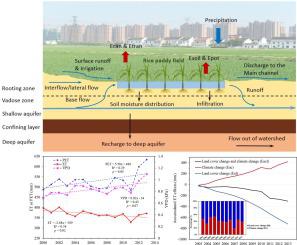当前位置:
X-MOL 学术
›
J. Hydrol.
›
论文详情
Our official English website, www.x-mol.net, welcomes your
feedback! (Note: you will need to create a separate account there.)
Combined effects of urbanization and climate change on watershed evapotranspiration at multiple spatial scales
Journal of Hydrology ( IF 5.9 ) Pub Date : 2020-08-01 , DOI: 10.1016/j.jhydrol.2020.124869 Di Fang , Lu Hao , Zhen Cao , Xiaolin Huang , Mengsheng Qin , Jichao Hu , Yongqiang Liu , Ge Sun
Journal of Hydrology ( IF 5.9 ) Pub Date : 2020-08-01 , DOI: 10.1016/j.jhydrol.2020.124869 Di Fang , Lu Hao , Zhen Cao , Xiaolin Huang , Mengsheng Qin , Jichao Hu , Yongqiang Liu , Ge Sun

|
Abstract How urbanization-associated land use/land cover change (LULCC) affects the ecohydrological cycle through altering evapotranspiration (ET) processes is not clear for rice paddy dominated watersheds. The purpose of this study was to understand long-term (2000–2013) spatial and temporal variations of ET over the Qinhuai River Basin in a humid region, southern China. We revised the Soil and Water Assessment Tool (SWAT) by incorporating new algorithms describing hydrological processes of rice paddies. Using the improved SWAT model driven by remote sensing-derived LULCC and local climatic data, we separated the effects of LULCC on ET from climate at the watershed scale. We showed that the modified SWAT model significantly improved monthly streamflow estimates. The Nash-Sutcliffe model efficiency (NSE) was 0.86 and coefficient of determination (R2) was 0.88 for the calibration period (1990–1994) while the NSE was 0.65 and R2 was 0.71 for the validation period (1995–1999). We also found good agreements between modelled daily ET and lysimeter-based measurements for an experimental rice paddy field (R2 = 0.75, p less than 0.01). For areas with little land cover change, ET rates increased over time due to the increase in potential ET (PET) during 2000–2013. However, the contribution from rice paddy to the watershed-level ET decreased over time coincident with a period of rapid urbanization and loss of rice paddy field. Dynamic attribution analysis indicated that the negative contribution of LULCC to change in ET increased from 53% in 2000 to 61% in 2013 while the positive contribution of climate variability decreased from 47% in 2000 to 39% in 2013. We concluded that factors affecting ET varied with spatial scale. Conversion of rice paddy field to urban use directly resulted in significant ET reduction at the watershed scale despite the rise in the air temperature and potential ET in the study region. The improved SWAT model provides a better integrated method for understanding ET processes and assessing the impacts of environmental change on ecosystem services in a rapidly urbanizing region.
更新日期:2020-08-01









































 京公网安备 11010802027423号
京公网安备 11010802027423号